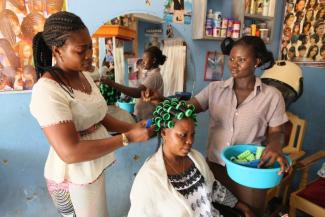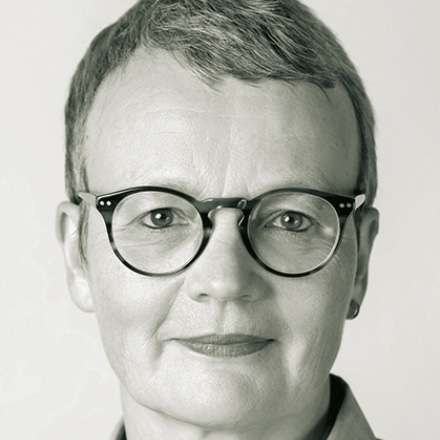Labour market
Disadvantaged women

The UN 2030 Agenda and in particular SDG 8 stress the relevance of employment for reducing poverty. SDG 8 commits the international community to achieving productive employment and decent work for all. The latest ILO trend report, however, shows that quite a lot must happen for that goal to be achieved. In 2017, the ILO expects global unemployment to affect 201 million people, 2.7 million more than in the previous year.
This moderate rise in unemployment is attributed mainly to deteriorating labour-market demand in emerging markets, especially Brazil. South America’s most populous country was hit by recession last year, but global economic growth was also weaker than expected. There is a general shortage of private-sector investment. Moreover, international trade is slackening. It thus does not seem likely that the business community will square the circle by creating more jobs and improving the quality of existing jobs at the same time.
Women are particularly disadvantaged. They are often denied access to the labour force. The situation is made worse by the growing number of young job-seekers and the slow pace of economic growth. Moreover, precarious forms of informal employment condemn many workers to a life of poverty and permanent insecurity.
Especially in developing countries, rising unemployment and the poor quality of available jobs are major problems. Masses of people are self-employed, for instance, or employed by relatives. Tunisian street vendor Mohamed Bouazizi, whose self-immolation in 2010 triggered the Tunisian Revolution, became a symbol of the plight of these people. His suicide was an act of desperation and protest. It was prompted by the repeated closure of his vegetable stall for lack of a permit and the subsequent harassment by officialdom and the police.
Precarious forms of employment are not confined to North Africa; they are even more widespread in South Asia and sub-Saharan Africa. They account for nearly half of global employment. According to the ILO, that will not change much in the foreseeable future.
Various scandals in recent years have shown that wage-earners in formal-sector employment are not necessarily much better off in developing countries. In Bangladesh’s garments industry, for example, many seamstresses not only work in terrible safety conditions, as the collapse of the Rana Plaza factory in 2013 showed. They also work for wages that they can barely live on.
The ILO forecasts that the number of the working poor is set to rise in the near future. It expects that, per year, an additional 3 million persons more will be earning less than $ 3.10 per day. As it points out, people with smaller incomes struggle to survive.
The poor working conditions in many emerging and developing countries prompt a growing number of able-bodied young people to migrate abroad. According to the ILO, nearly one third of the people living in sub-Saharan Africa can imagine abandoning their homeland for the dream of a better life. The continuing flow of refugees who set off to Europe from the North African coast is evidence of this trend. At the same time, the willingness to migrate is growing in Latin America, the Caribbean and North Africa.
In contrast to the situation in developing and emerging countries, unemployment rates are going down in the industrialised world, though not as fast as in recent years. According to the ILO, the problem in developed countries is mainly structural unemployment. It is driven by new technologies and the outsourcing of manufacturing to lower-income countries. North America’s “rust belt” has been hit, for example. In Europe, nearly half of the jobless have now been out of work for more than a year.
Regardless of state borders, women are the most disadvantaged group in the global labour market. Less than half of the world’s women even participate in the labour force, which means they are either in employment or looking for a job. The ILO reckons, however, that more than two-thirds of women want to work.
The reasons for the low rate of women’s labour-force participation are mainly socio-economic and are related to family status, lack of transport opportunities or ideas about work-life balance. Another important issue is that some families and societies simply do not appreciate women’s desire to work.
Looking at the different world regions, the ILO reports that the gulf between male and female labour force participation is widest in the Arab states, North Africa and South Asia (see Nassir Djafari, p. 28). In these regions, the difference in labour-force participation exceeds 50 %.
Another challenge is that, even when women are included in the labour force, they are more likely to be unemployed than men. For 2017, the ILO expects global unemployment rates of 6.2 % and 5.5 % for women and men respectively, and this gender gap is not set to become narrower in the next few years. The figures are once more worst for the Arab states and North Africa, where women’s unemployment rate is twice as high as men’s and exceeds 20 %.
If one takes paid and unpaid work into account, however, the female members of a family are likely to work more hours than their male counterparts. The reason is that they spend time with household chores, child care and looking after elderly relatives. Women are also more likely to be contributing work to a family business.
Another gender disparity is in the sectoral pattern of male and female employment. Women tend to work in education, health care and other social sectors as well as in the wholesale and retail trade. The ILO reports that the propensity of men and women to be engaged in different sectors has increased in the past 20 years.
In 2014, the G20 committed to reduce the gap in labour-force participation between men and women by 25 % by the year 2025 (the “25 by 25” goal). This would not only imply a greater number of jobs; it would also boost global economic output by almost four percent. The Arab states, North Africa and South Asia would benefit in particular. Quite apart from the economic advantages, paid work would create better opportunities for many women’s personal fulfilment.
According to the ILO analysts, it is essential to change the way many societies view working women in order to involve more women in the labour force. At the same time, it is necessary to improve working conditions for women.
The ILO makes the following specific recommendations:
- Equal pay for work of equal value should be enshrined in national law.
- The sectoral segregation of men and women should be mitigated by equal access to education opportunities. Moreover, health care and social professions should be appreciated more.
- Legislation against gender-specific discrimination makes sense. Public awareness campaigns, equality bodies and sanctions should then support law enforcement.
- Working conditions for men and women should be made more family-friendly to achieve a better work-family balance.
- Conditions must improve in the women-dominated care sector. At the same time, unpaid care work should be reduced and public services improved.
- Informal jobs should be formalised. That step disproportionately benefits women.
Apart from the measures specifically designed to promote women, the ILO demands that the causes of both cyclical and structural unemployment be addressed. It considers public investments a good way to boost national economies.
Linda Engel is a free-lance writer.
lindaengel@gmx.de
Links
ILO, 2017: World employment social outlook. Trends for women 2017.
http://www.ilo.org/wcmsp5/groups/public/---dgreports/---inst/documents/publication/wcms_557245.pdf
ILO, 2017: World employment social outlook. Trends 2017.
http://www.ilo.org/wcmsp5/groups/public/---dgreports/---dcomm/---publ/documents/publication/wcms_541211.pdf
















